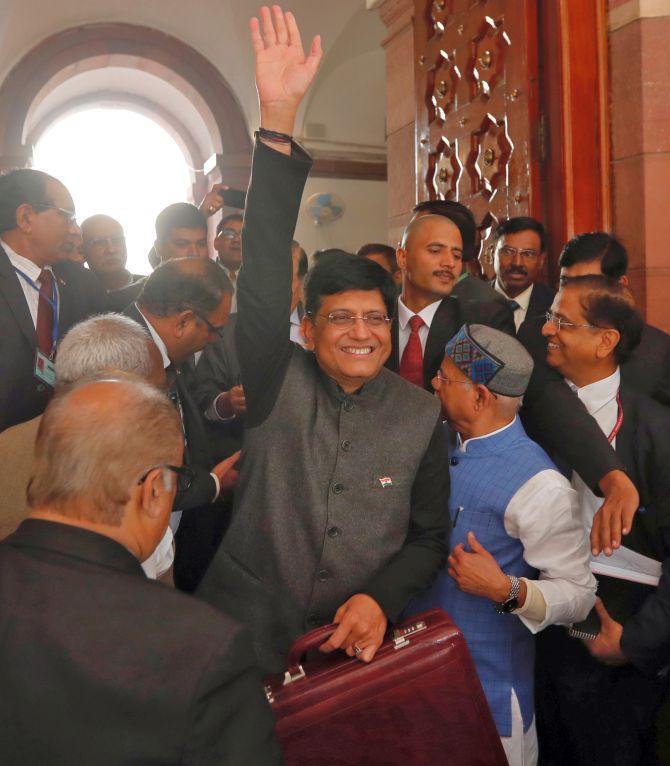'We get an overzealous army of tax inspectors pushing the economy too hard,' says Ajay Shah.

While we take in the Interim Budget, this is a good time to think about the larger picture.
The budgetary process and fiscal policy in India now face two big problems.
The first is the mismeasurement of GDP and potentially its over-estimation.
This has important consequences for tax targets and the bond issuance programme.
The second is the emergence of population-scale entitlement programmes.
These have induced adverse effects upon the political economy worldwide; India will need to build the countervailing forces to check and balance the political imperative.
The interim Budget will be in force for April-June, and then the next team will come out with a July Budget speech which will make decisions that will shape Union government policy for the rest of the year.
This last Budget is, however, a good time to stop and take stock of the Indian budgetary process and the challenges of fiscal policy.
The first looming question that I see is that of GDP data.
Everyone knows that official statistics in India are untrustworthy.
This is considered an obscure problem, of interest to only economists.
However, GDP data has direct consequences in one sphere: budget-making.
In each Budget process, the GDP number comes in, gets multiplied by roughly 0.08, and this becomes the target for the vast tax bureaucracy.
Errors in GDP estimation induce errors in the tax targets. The tax revenue for 2018-2019 was 7.9% of GDP, and the tax target for 2019-2020 has been set to 8.1% of GDP.
We in India are reasonably certain that there are important errors in GDP estimation.
Some independent data sources -- corporate sales, corporate profits, private investment -- suggest that the official GDP data is over-estimated.
As an example, from 2014-2015 to 2017-2018 (three years), nominal GDP went up by 37%, but the nominal net sales of the 5,019 non-oil, non-finance companies went up by 22%.
If GDP is over-estimated, the tax targets are too high.
We get an overzealous army of tax inspectors pushing the economy too hard.
This becomes one source of stress for the economy.
In 2014-2015, the net tax revenue (BE) was Rs 9.8 trillion and was supposed to be 7.5% of GDP.
Five years later, it stands at Rs 17.1 trillion and is supposed to be 8.1% of GDP.
Did nominal GDP go up by 62% in these five years, as was assumed in making the Budget?
The Budget calculations that lead up to the bond issuance programme are also affected by mismeasurement of GDP.
If GDP is over-estimated, the magnitude of bond sales is too large, compared with what the economy can absorb.
While the lack of GDP data really harms tax policy, it is possible to keep government debt on track even when GDP is mismeasured.
There is one robust rule about debt dynamics that does not require a GDP estimate.
If we run a primary surplus, we are paying down debt and the debt/GDP ratio is going down for sure, even if we do not know what GDP is.
It would be prudent for fiscal policy makers in our data-poor environment to use such a rule.
Right now, in India, the primary deficit is about Rs 40,000 crore.
To come up to the demands of this robust rule requires a reduction of the deficit by Rs 40,000 crore, which is not a large adjustment.
This would protect us from the possibility of faulty fiscal policy calculations flowing from faulty GDP estimates.
The second looming concern in public finance is the rise of population-scale entitlement programmes.
When we look back in our history, the costliest single decision made by the Union government was one-rank-one-pension.
Expressed in net present value terms, this was the biggest single decision, ever, in the history of the Indian State.
While the US has 20 aircraft carriers, we might have been able to buy 40 aircraft carriers using the net present value (NPV) of this decision.
The trouble is that the NPV of one-rank-one-pension was not computed before decisions were taken.
Even today, we do not know how much this costs.
An array of new promises are now coming along, particularly in the fields of health and pensions.
So far, we have not yet reached the level of irreversibility in these areas that is seen with one-rank-one-pensions.
The administrative capacity to execute these systems has not yet been built, and most citizens have not felt promises translate into action, so policy makers continue to have wiggle room to extricate themselves.
But this window for policy flexibility is closing as the implementations come about.
Policy makers worldwide have learned the hard way that these kinds of entitlement programmes are a very troublesome matter, and every decision should be made while comparing the short-term political gains versus the NPV over a 75-year horizon.
As with one-rank-one-pensions, the new promises that are coming along in India, in health and pensions, are not backed by these calculations.
It is all too easy to fall for a tempting programme based on a projected expenditure for next year.
We in India are at the early stage of middle income.
We are coming into the zone of prosperity where entitlement programmes appear affordable when 75-year calculations are not made.
It is essential to build the institutional apparatus through which countervailing forces are brought into these decisions.
The institutional apparatus of the (presently weak) bond market, the (currently absent) Public Debt Management Agency and Fiscal Council is required, to bring rationality into the Budget process.
As we graduate from captive bond buyers to a market-based system where bond buyers are voluntary, difficult questions will be asked about fiscal soundness on long-term horizons.
The bond market is the key counterweight to the political pressures in favour of announcing more generous entitlement programmes.
We have come into middle income, and we now urgently require the institutional apparatus of a middle-income economy to determine our fiscal policy.
This involves GDP measurement, a non-coercive bond market, the PDMA, and the Fiscal Council.
Ajay Shah is a professor at the National Institute of Public Finance and Policy, New Delhi.












 © 2025
© 2025